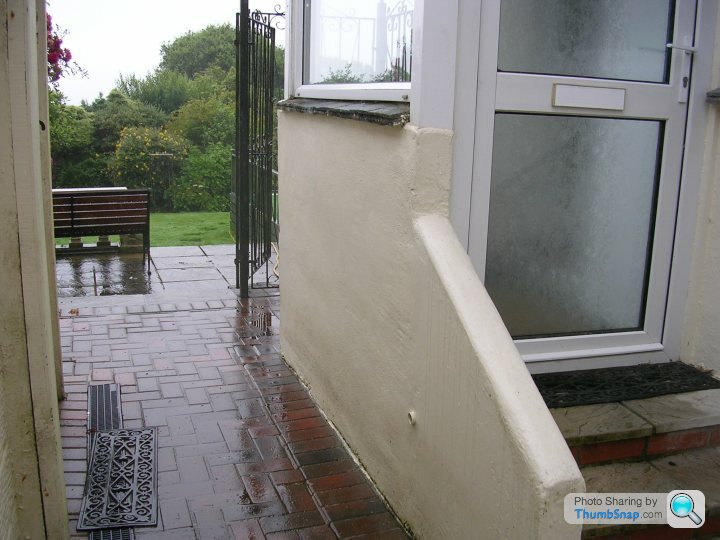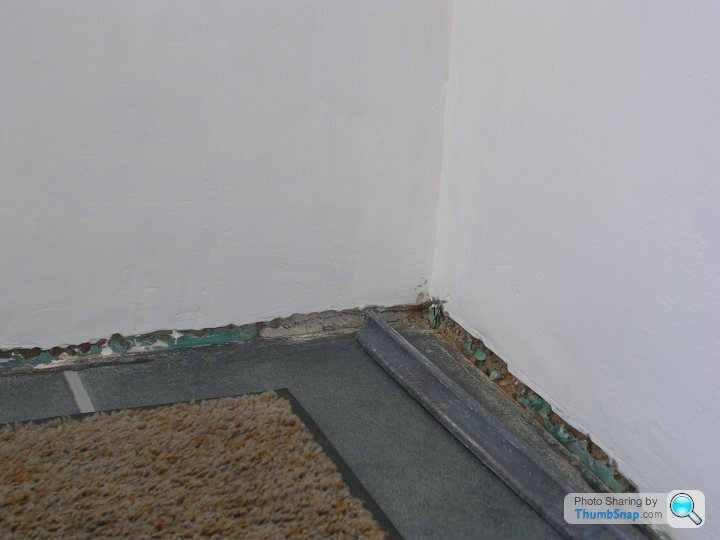Ongoing damp porch problem
Discussion
I raised this in another thread a few months ago.
It's a single, rendered concrete block wall, probably with no DPC. Damp from the leaking roof has been fixed. Damp rising to the floor itself has been fixed with a DPC (you can see bits of it in the photos) and a layer of thick foam sandwich under the actual floor. I suspect the rest of the sub-floor base is filled with rubble but no proof.
All outside glass is double glazed, one window is ajar and we have a small vent in the smaller wall.

I've been scraping/peeling off the paint prior to repainting, with no sign of damp for several months. However, after a day and a half of rain these damp patches appeared this morning.
12:10 Humidity a little high.

so I put our dehumidifier out there.
A bit later:

Later:

In the meantime I've done as much research as I can.
The rest of the wall has stayed dry - no condensation. So it's probably rising damp because the outside blocks are sealed with render and paint but the block pavers have replaced thick gravel which would have held water. Yes/no?
If that's the case, one online 'expert' would recommend stripping (some of) the render off - say the bottom 30cm.
Any knowledgeable advice would be welcome.
It's a single, rendered concrete block wall, probably with no DPC. Damp from the leaking roof has been fixed. Damp rising to the floor itself has been fixed with a DPC (you can see bits of it in the photos) and a layer of thick foam sandwich under the actual floor. I suspect the rest of the sub-floor base is filled with rubble but no proof.
All outside glass is double glazed, one window is ajar and we have a small vent in the smaller wall.

I've been scraping/peeling off the paint prior to repainting, with no sign of damp for several months. However, after a day and a half of rain these damp patches appeared this morning.
12:10 Humidity a little high.

so I put our dehumidifier out there.
A bit later:

Later:

In the meantime I've done as much research as I can.
The rest of the wall has stayed dry - no condensation. So it's probably rising damp because the outside blocks are sealed with render and paint but the block pavers have replaced thick gravel which would have held water. Yes/no?
If that's the case, one online 'expert' would recommend stripping (some of) the render off - say the bottom 30cm.
Any knowledgeable advice would be welcome.
I would imagine rainwater from the ground is being sucked up in to the render and through the block and into the internal render/plaster. It may work to remove the lower 150mm or so and put a trim on. Maybe a brush-on water sealer may help with the block that is left exposed, but if water is being sucked up into the block from below, it may be more difficult to solve.
Whilst it is good practice to have a belcast, it appears your floor is approximately 18 inches above the paving. At this sort of height the benefit is minimal and it certainly couldn't cause the damp you have after a day and a halfs rain. The water would need to rise by capillary action between the wall and render (and travel through the thickness of the wall to manifest itself inside) and that takes time, if it were even physically possible.
I would suggest you hack the plaster back to about 3" above the floor as a first measure. It's not clear whether your damp is coming down, around the floor membrane or through the render, but you may find it's acceptable once you've trimmed the plaster back. Using treated skirting, or even better PVC skirting, should prevent any rot.
I would suggest you hack the plaster back to about 3" above the floor as a first measure. It's not clear whether your damp is coming down, around the floor membrane or through the render, but you may find it's acceptable once you've trimmed the plaster back. Using treated skirting, or even better PVC skirting, should prevent any rot.
SAB888 said:
I would imagine rainwater from the ground is being sucked up in to the render and through the block and into the internal render/plaster. It may work to remove the lower 150mm or so and put a trim on. Maybe a brush-on water sealer may help with the block that is left exposed, but if water is being sucked up into the block from below, it may be more difficult to solve.
I thought you might appreciate an update. As you can probably see, I started by using a masonry drill to cut a groove just above the floor line where there had previously been rising damp. I stopped when I reached dry building block, which was a couple of cm deep near the corner.
No stain appeared after the first rainy period. I drilled a few holes, just below floor level, upwards from the outside, deep enough to pass right through the wall into whatever was under the floor. I expected to meet wet stuff but didn't. Nothing appeared through these holes and no stains appeared inside after more rain. So I painted the walls. Quite a lot of rain recently and still no sign of damp.
When I glue the moulding back onto the floor (not to the walls as the floor moves) it should almost cover my groove yet allow any rising damp to evaporate, if that's what's happening.
Thanks.
Gassing Station | Homes, Gardens and DIY | Top of Page | What's New | My Stuff



